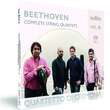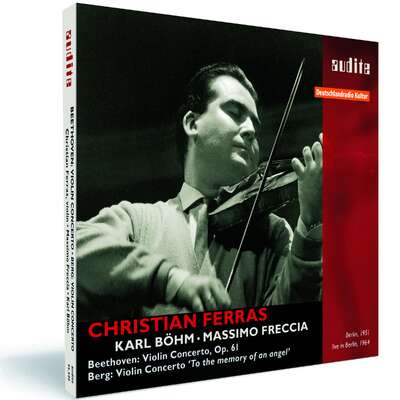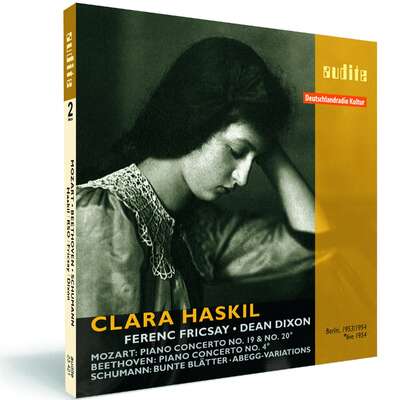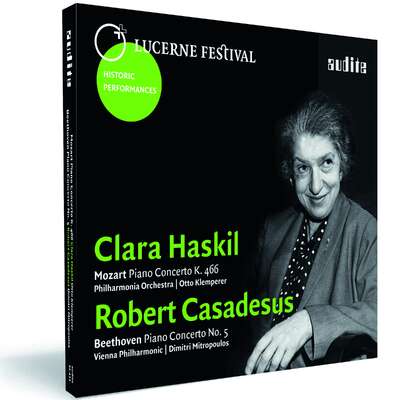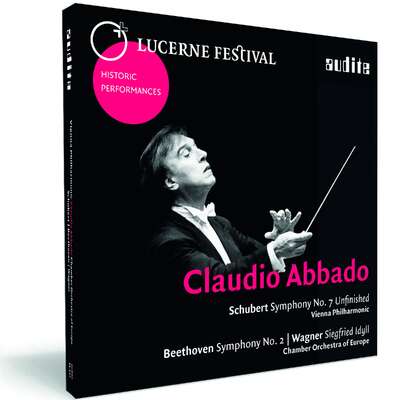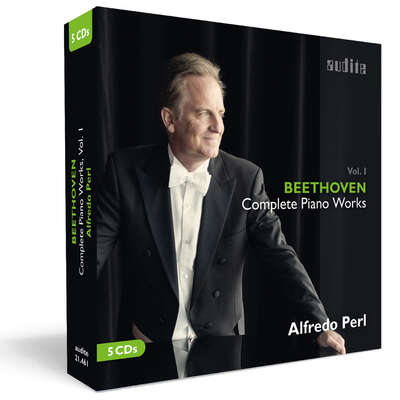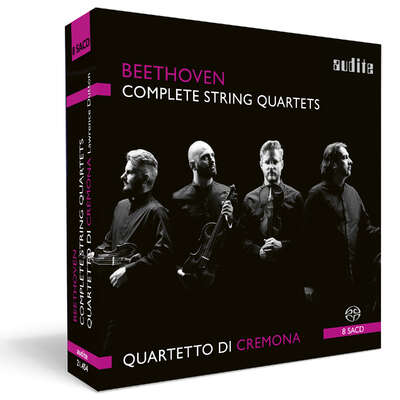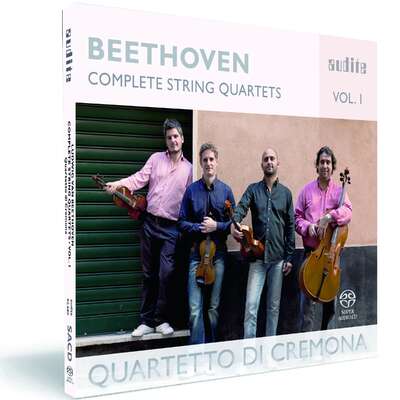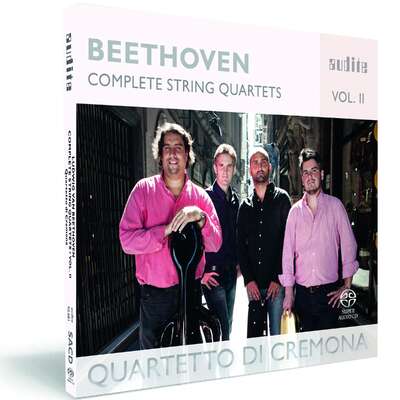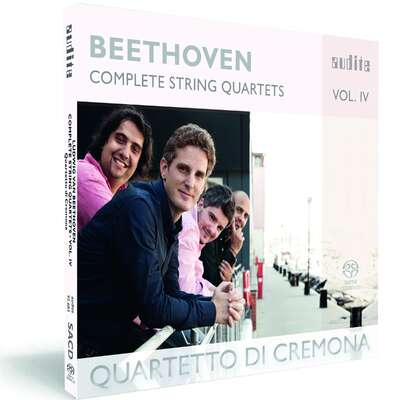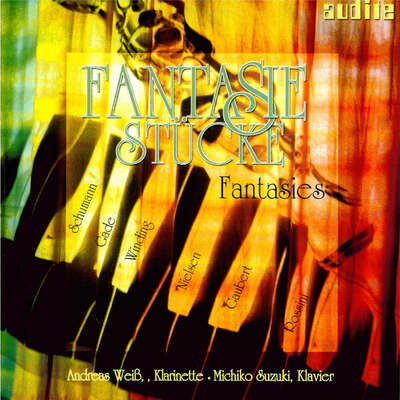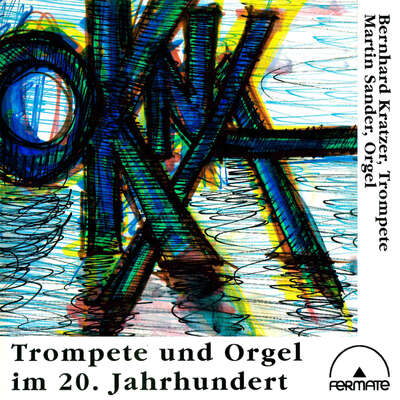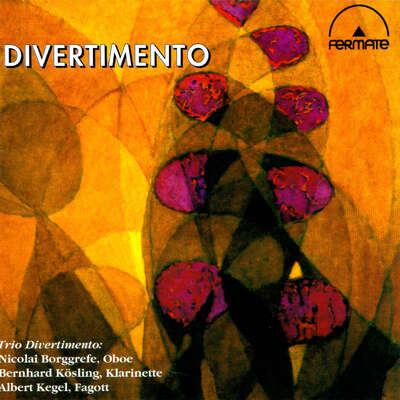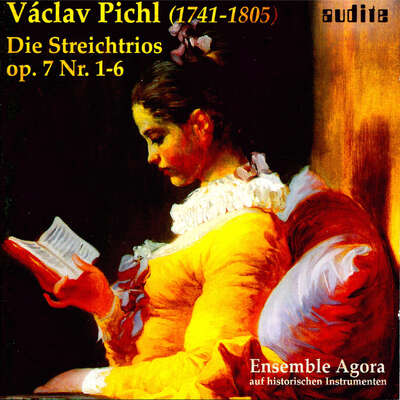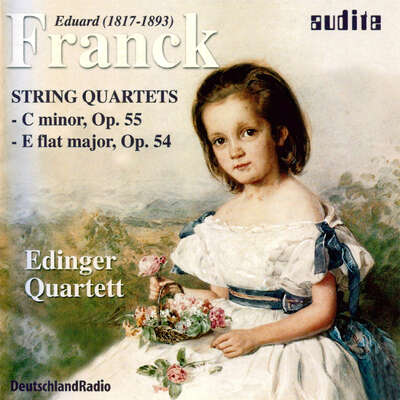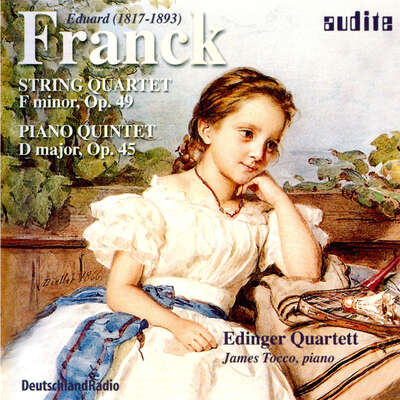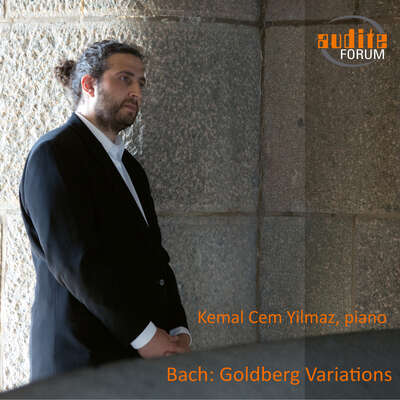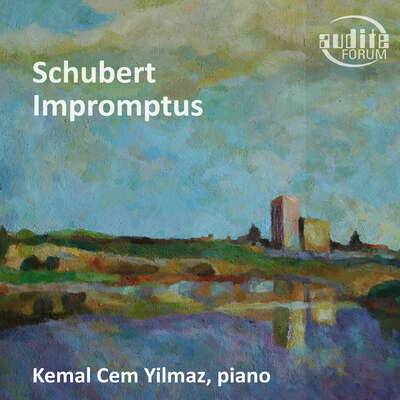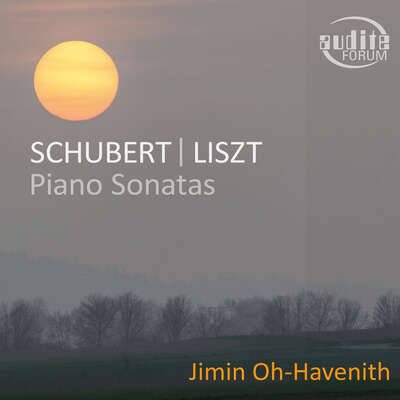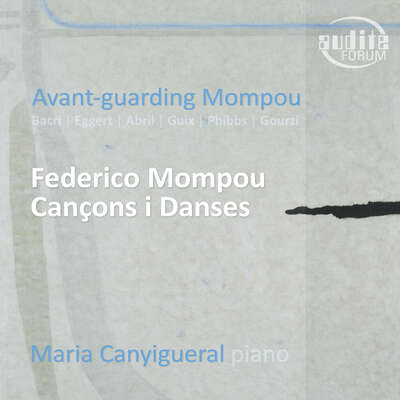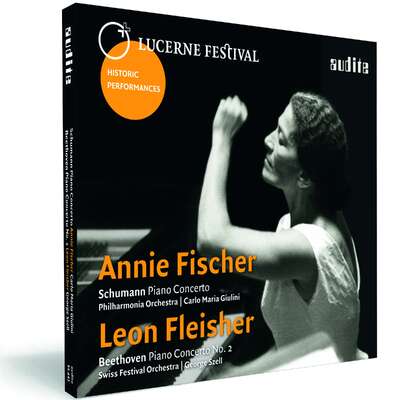
In the Quartetto di Cremona’s third volume of the Complete Beethoven String Quartets, enthusiastically received by press and audience, the ensemble undertakes a bold triple jump through Beethoven’s different stages of musical development. Presented here are the C minor work from the first, ingenious set of quartets Op. 18, the first of the highly virtuosic “Razumovsky” Quartets Op. 59, as well as the “Great Fugue”, Op. 133, a pinnacle of musical artistry.more
"Das Kompetenzteam aus Cremona geht an diese Aufgabe mit Selbstbewusstsein, aber ohne Fahrlässigkeit heran, lässt sein Temperament vorpreschen und den langen Atem dennoch bewahren. So gelingt eine Quadratur des Zirkels aus Klangfinesse und Ausdruckstiefe, die Beethovens Geist überzeugend reflektiert." (Spiegel)
Details
| Ludwig van Beethoven: Complete String Quartets - Vol. 3 | |
| article number: | 92.682 |
|---|---|
| EAN barcode: | 4022143926821 |
| price group: | ACX |
| release date: | 16. May 2014 |
| total time: | 78 min. |
Bonus Material
Informationen
"The reviewer dares not interpret the meaning of the fugal finale: to him it seemed unfathomable, like Chinese." Ludwig van Beethoven frequently aroused incomprehension amongst contemporaries with his late quartets. But no work seemed to his audience of 1826 as "Chinese" as the monumental movement that Beethoven had composed in the seemingly familiar form of the fugue. Ever since, the "Great Fugue" - originally the finale of the Quartet Op. 130 - has been surrounded by the nimbus of his extreme, almost impenetrable tenacity.
The Quartetto di Cremona have made the monumental Fugue Op. 133 the centrepiece of the third volume of their Complete Beethoven String Quartets recording series. The monolithic movement is flanked by two works from Beethoven's early and middle periods. The fourth Quartet of the first set, Op. 18, does not yet interpret the home key of C minor as fateful (as is the case later in the Fifth Symphony), but turns the quartet style of Beethoven's teacher Joseph Haydn towards the agitated. However, with the first Quartet of the revolutionary set of Op. 59, dedicated to the Russian Count Razumovsky, Beethoven looks far ahead into the future and composes a grandiose first movement, an expansive, sensitive Adagio and a finale in which he bows to his commissioner with a "Thème russe".
Instruments:
violin I: Guarneri del Gesù
violin II: Giovanni Battista Guadagnini, 1752 (Great Fugue)
violin II: Salvatore Scalia, 2012 (Op. 18 No. 4 / Op. 59 No. 1)
viola: Pietro Gargini, 2012 (Great Fugue)
viola: Alberto Giordano, 1995 (Op. 18 No. 4 / Op. 59 No. 1)
cello: Marino Capicchioni, 1974
Reviews
deropernfreund.de | 24.8.2017 | Egon Bezold | August 24, 2017 Edle kammermusikalische Kost
Welches Quartett kann es sich schon leisten am Mikrokosmos der Beethoven-Streichquartette vorüberzugehen? Die komplette Edition hat das Cremona TeamMehr lesen
Simone Gramaglia meldet sich in den Mittelstimmen zu Wort. Mit Klang und Kraft bedient Giovanni Scaglione den Cello-Part. Was die Vierertruppe auszeichnet ist die artikulationskräftig erfrischende Art wie der Quartett-Text verdeutlicht wird, ohne dass jemand auf den Gedanken käme allzu deutlich mit dem didaktischen Zeigefinger aufzuzeigen.
Voller Überraschungen steckt die Wiedergabe der frühen sechs Quartette aus op. 18, die aufgrund der stilistischen Problematik mit zu den vertracktesten des Quartett-Zyklus zählen. So flitzen die schnellen Sätze als Kabinettstücke in spieltechnischer Präzision vorüber. Flexibel reagiert die Viererformation auf die Stimmungsumschwünge. Schlüssige Tempi markieren den Pulsschlag einer glutvollen Wiedergabe. Da wird nicht nur der Geist Haydns und Mozarts geweckt, sondern auch der mittlere und späte Beethoven vorausgedacht. Den klingenden Beweis liefern die kurzangerissenen Akkorde aus dem c-Moll op. 18,4. Auch das heikle Quartett op.18,5 gerät zum spannungsgeladenen Akt für fein ziselierte, nervig rhythmisierte Quartettkunst.
Hohe interpretatorische Intelligenz charakterisiert die Wiedergabe der mittleren Werkgruppe op. 59. Als eminent schweres Prüfstück erweist sich für die Primgeige das e-Moll Nr. 2, das Günther Pichler, der Ex-Primarius des Alban Berg Quartetts, als vertrackter als den Solopart des Beethoven-Violinkonzerts charakterisiert hat. Und es stimmt alles: die Spieltechnik, die sensibel ausgeschriebenen Übergänge, auch die vibrierenden Sechzehntelpassagen, die in der sich verflüchtenden Atmosphäre zu Tage treten. Welch fein abgetönte Stimmung prägt das ruhig genommene, breit ausgespielte „Adagio con sentimento“, das vorbildlich ausgewogen im Ausdruck fasziniert. Atem nehmend die akrobatische Fuge aus dem dritten Quartett, die selbst für ein professionelles Team eine Hürde darstellt. Dass dieser Sturmlauf wohl zum radikalsten gehört, was in der Sektion „Perpetuum mobile“ geschrieben wurde, machen die Cremona Leute klangartistisch zur Hetzjagd nach Noten.
Zur klanglichen Delikatesse gerät das Finale des ersten Satzes aus dem „Harfenquartett“ op. 74. Unwirsch springt einen das f-Moll Quartett op. 95 ins Gesicht. Da wird der musikalische Trotz buchstäblich auf die Spitze getrieben. Der große Gipfelsturm auf die Monster der späten Quartette, wo sich Spiritualität und geistiger Anspruch auf faszinierende Weise durchdringen, beginnt mit dem Es-Dur Quartett op. 127. Organisch gelingt die Darstellung, nirgends wird der natürliche Strom der Musik unterbrochen. So gewinnt das endlos fließende durch subtiles Variationenwerk angereicherte Adagio troppo, molto cantabile durch Ausspielen der harmonischen Reibungen besonders an Leuchtkraft. Dieser ausladende Satz wird mit viel Innenspannung aufgeladen. Da ist ein Auseinanderbröckeln ausgeschlossen. Mit welcher Reaktionsfähigkeit das Team die Stimmungsumschwünge realisiert, macht Staunen. Zum Quartett-Komplex zählt auch die Große Fuge B-Dur op.133 – ein nachkomponierter Bestandteil, der 6. Satz der Originalversion des Quartetts op. 130. Zu bewundern ist auch im a-Moll op. 132 der wunderbar ausgespielte „Heiliger Dankgesang eines Genesenden an die Gottheit“. Energisch durchgeformt erscheint das Alla marchia des vierten Satzes und die fulminant hoch wirbelnde Final-Stretta.
Die suitenartig aneinander gereihten Abschnitte im cis-Moll Quartett op. 131, die Beethoven ja auf das Komplizierteste nahtlos miteinander verzahnte, stiften überzeugende Einheit. Da werden die durchsichtig gespielten Details, die liberal behandelte Sonate nie aus dem Auge verloren. Im ersten Allegro kommen die Akzente konturenscharf. Innere Ruhe verströmen die schier endlos sich hin dehnenden Variationen. Es gibt keine Stimmenkorrespondenz, keine rhythmische Spannung, kein dynamischen Ansatz, über die vom Vierer Team flüchtig hinweg gespielt worden wäre. Von bohrender Kraft und beispielhaftem Standvermögen kündet der Finalsatz.
Diese exemplarische Auslegung bannt die Tontechnik auf das Format „Souround Sound – spielbar auf CD und SACD Player“. Das kammermusikalische Profil öffnet reizvolle kompositorische Perspektiven, vermittelt einen tiefen Einblick in Beethovens kammermusikalische Meisterschaft. Schulbildend für die Cremona Gruppe ist der Deutsch-Österreichische klassisch geprägte Stil (in Bezug auf Werktreue, Form und Stil) wie von Hatto Beyerle vom Alban Berg Quartett und in Fortsetzung von Piero Farulli vom Quartetto Italiano gepflegt wurde. Hier verbinden sich ein leidenschaftlich-emotionaler Ansatz mit romantisch geprägten Elementen sowie italienischer klanglicher Ästhetik. Da verschmelzen Struktur, Ausdruck und Form zur glühenden inneren Leidenschaft.
Crescendo Magazine | Le 4 décembre 2014 | Bernard Postiau | December 4, 2014 Suite d’une intégrale qui ne s’impose pas
BEETHOVEN (1770-1827) Quatuors à cordes opus 18 n° 4, opus 59 n° 1 etMehr lesen
American Record Guide | December 2014 | Paul L Althouse | December 1, 2014
This is the third volume of the Cremona’s Beethoven Quartets. The first installment with Quartets 6, 11, and 16 was reviewed by Greg Pagel (S/OMehr lesen
If there are problems with maturity, they don’t show up in Quartet 4, an enthusiastic, dramatic affair from early in Beethoven’s career. The playing is sharply articulate, enthusiastic, and somewhat Haydnesque—in other words, a fine, outgoing, “young” performance. Some of my characterization of the playing comes from the sonics, which are bright and leave violinist Cristiano Gualco sounding a bit wiry; put another way, the CD hasn’t very much warmth, so this doesn’t sound like a burnished German group.
Quartet 7 (Razoumovsky 1) is nicely done—standard tempos with fine control of the many exposed places. I was particularly pleased that when called for, their playing can be very quiet. Many groups glide over Beethoven’s dynamics and sforzandos, but the Cremona observes them well, bringing interest to the piece without calling undue attention.
As for Quartet 16, the Grosse Fuge, I’m never sure what to say. The piece seems to be overwhelming in its intellect and emotion, but I’m not certain I “get it”. At any rate the Cremona, like most quartets, slash and burn their way through the piece.
In sum I have a better impression of the Cremona in this installment, even if I wouldn’t place them with the Quartetto Italiano quite yet. The bright sound is a small impediment for me, but on different equipment with surround sound it might be perfectly fine.
www.pizzicato.lu | 20/10/2014 | Remy Franck | October 20, 2014 Emotionaler Strudel
Zunächst ist man sprachlos, aufgewühlt, wenn die letzten Töne dieser Einspielung verklungen sind. Erst allmählich wird man sich dann bewusst,Mehr lesen
The Quartetto di Cremona digs deep into Beethoven’s music, thus revealing a whirl of emotions like we never experienced in this music.
Stereo | 10/2014 Oktober | Marcus Stäbler | October 1, 2014
Auffällig sind etwa die perfekt getimten Zäsuren innerhalb der Sätze, mit denen das Ensemble die Partitur in ihre Sinnabschnitte gliedert. Diese analytische Klarsicht paart sich mit einem großen Reichtum an Farben, Charakteren und Emotionen.Mehr lesen
BBC Music Magazine | October 2014 | EL | October 1, 2014
Early, middle and late Beethoven is projected with visceral excitement and pulsating energy by this gifted quartet. Occasionally I missed a moreMehr lesen
Ensemble - Magazin für Kammermusik | 5-2014 Oktober / November | Robert Nemecek | October 1, 2014 Sinnlich und direkt
Die Musiker begegnen Beethovens Musik auf eine sehr sinnliche und direkte Art, aus der Interpretationen hervorgehen, die sich durch ein hohes Maß an Plastizität, Strahlkraft und Expressivität auszeichnen. Eine vollkommen ausgereifte SACD-Technik macht jedes Detail hörbar. Als Hörer kommt man Beethovens Musik so nahe wie nur möglich.Mehr lesen
Fono Forum | September 2014 | Marcus Stäbler | September 1, 2014 Eindringlich
Eine gute Balance aus Gefühl und Verstand, aus geistiger Durchdringung und Leidenschaft gehört zu den wichtigsten Schlüsseln für eine zwingendeMehr lesen
Viel schroffer dagegen die Kontraste in der "Großen Fuge", die vom vibratolosen Flüstern bis zu explosiven Attacken eine gewaltige Spanne aufreißt. Hier geht das Ensemble immer wieder an die Grenzen des traditionellen Schönklangs – ganz im Sinne von Beethovens vielleicht verstörendstem Spätwerk, in dem die Extreme auf die Spitze getrieben sind. Auch dort finden die Italiener die richtige Mischung aus Kontrolle und Hingabe – und fördern die existenzielle Dringlichkeit der Musik zutage.
International Record Review | September 2014 | Michael Jameson | September 1, 2014
Each volume of this evolving Beethoven quartet cycle from the Quartetto di Cremona usefully encompasses works from all three creative phases of theMehr lesen
With this new SACD release, Volume in Audite's series , that creative evolution and attendant polarization of form and ideas seems even more startling than before. The reason for this is no t hard to determine; the programme combines the tersely belligerent C minor Quartet from the Op. 18 group with the Grosse Fuge and the first of the middle period 'Razumovsky' Quartets, Op. 59. It would be hard to cherry-pick a more challenging or more representative group from among Beethoven's quartets, making this compilation particularly appealing, one imagines, to anybody for whom these works might still be terra incognita.
However, so far, this series has had mixed fortunes. Variable performances from the Cremona Quartet haven't always lived up to the expectations their heritage seems to have conferred upon them, as perceived successors to the illustrious Quartetto ltaliano. Consequently in an already oversubscribed field, these accounts probably won't be the ones most of us would choose to live with, despite much that's entirely praiseworthy: the highlight here is an ardent account of Op. 59 No. 1 that seems to me to be the finest individual performance I've heard so far in the Cremona Quartet's cycle.
The C minor Quartet, Op. 18 No. 4, owes much to the minor-key works of Haydn, in particular to the second in the Op. 76 set, the D minor Quartet popularly known as the 'Fifths'. Speeds are invigorating; and with bristling attack and mercurial Mediterranean passions simmering away, this was always going to be an exciting account! Yet there are moments which don't quite come off, particularly in the Andante, and the tiered dynamics and syncopated abruptness of the Menuetto find these players in less than full accord, though the finale goes very well indeed.
In the Grosse Fuge climaxes are reached too soon, motorically and expressively, and amid this torrential onrush, the team begins to flag well before the music has run its course. This proved a considerable disappointment, particularly when compared to the superlative account from the Belcea Quartet, whose visionary playing of all these works has raised the bar in the interpretation of the Beethoven string quartets by several notches in the recent past.
Finally things begin to go well, however, and the Quartetto di Cremona ends Volume 3 of its Beethoven cycle in fine style, with a thoroughly assured performance of the first 'Razumovsky' Quartet. If the playing cannot match the overall tonal cohesion of the Belceas, this is a solidly reliable reading nonetheless, which ticks most, though not quite all, of the right boxes. The biggest problem you'll detect at the outset is the somewhat anonymous character of the playing. Certainly the opening movement goes well for the most part, though the cello's introduction of the 'Eroica'-like first subject seems to lack something in presence and character, whereas the Belceas sound altogether more intrepid and purposeful. The Cremonas need time really to find their feet here, but when they do, there's crisply alert ensemble playing and a genuinely convincing sense of teamwork which hasn't always been so much in evidence previously.
The pointed Scherzo hasn't quite the metrical rigour of the Belceas' version, and dynamics are not so strongly attenuated, but this impression may well derive from the recording, made in a fairly reverberant auditorium, than to any particular shortcomings in the playing itself. The slow movement brings moments of heart-rending expressivity, however, and these players are at their impressive best when they allow the music to unfold at its own natural pace; the transition into the Russian•inspired finale, one of the most dangerous and unpredictable passages in Op. 59 No. 1, is nicely managed too.
Audite's production is never sonically the equal of Zig-Zag's exceptional Belcca Quartet recordings, but the sound is bright and well balanced. With Michael Struck-Schloen's informative booklet notes to hand, this is much the best disc in this series to date.
Classical CD Choice | August 13, 2014 | Barry Forshaw | August 13, 2014 | source: http://www.cdcho... From Strauss to Superman: New titles from PentaTone, Silva Screen, etc.
[...] a truly impressive cycle. [...] a pinnacle of musical artistry.Mehr lesen
Gramophone | August 2014 | Harriet Smith | August 1, 2014
I got my first taste of the Quartetto di Cremona in a survey of Beethoven chamber music last summer. Now they've reached Vol 3 of the quartets and theMehr lesen
The Strad | Monday, 28 July 2014 | Edward Bhesania | July 28, 2014
There’s no shortage of bite or energy in the third instalment of the Cremona Quartet’s survey of Beethoven’s string quartets. The instruments speak with crisp articulation and the players don’t hold back in terms of vigour. This often makes for thrilling listening.Mehr lesen
www.musicweb-international.com | July 2014 | Brian Wilson | July 1, 2014
The Belcea Quartet and Quartetto di Cremona are both comparatively youthful ensembles who have made fine reputations in a short time.<br /> <br /> Let me getMehr lesen
Let me get one complaint out of the way first: unlike the eclassical.com La Dolce Volta album, neither of the downloads of the Cremona Quartet from audite.de nor the one from eclassical.com comes with a booklet; only for Volume 1 of this series can a booklet be obtained from Naxos Music Library. The same holds true for the Zig-Zag download from 7digital.com – and, indeed, all downloads from this source. Download purchasers deserve to have all the apparatus that comes with the CD or SACD. Having said that, however, I must point out that the multi-lingual booklet which came with my press download of the Belcea Quartet is not very informative, with more photos of the quartet than analysis of the music.
The Quartetto di Cremona, formed in 2000, plunged in at the deep end in 2013 with quartets from Beethoven’s early, middle and late periods. So far they have recorded the three volumes listed above.
The Belcea Quartet have won awards in several quarters for their Beethoven and Stephen Greenbank thought this cycle an impressive achievement to which he planned to return often – review. Their recordings are also available on two 4-CD sets but the 8-CD set represents a considerable saving, unless you download from classicsonline.com, who haven’t realised that this is a bargain set and are asking £63.92 (mp3) or £71.92 (flac) for a set which you should be able to find on CD for about a third of that price – at least COL throw in the booklet.
Comparisons may be odious – or odorous as Dogberry would have it in Much Ado about Nothing – but I’m going to compare the two groups in one each of the early, middle and late quartets and both with Op.130 and Op.133 from the Talich Quartet.
Aline Nasif thought that the Belcea Quartet, live at the Wigmore Hall in 2004, gave a very fine performance of Op.18/3, though he wondered if they put quite enough feeling into the slow movement – review. That might have been a good place for a comparison, but the Audite series has not yet included Quarettto di Cremona in that work for comparison, so I’ve chosen Op.18/6 instead. Both ensembles choose tempi in all four movements very similar to each other and to those on my benchmark Takács Quartet recording (Decca). Both do all they can to stress the maturity of this early work and if the Belcea Quartet slightly lack the vigour of the Quartetto di Cremona in the opening work, that may be due to the lower quality of the outhere.com press download – concerning which, see below.
So far Audite have recorded two of the middle-period Razumovsky Quartets. Stephen Greenbank praised the Belcea recording of Op.59/1, so that’s the one that I shall compare. Here again tempi are very similar, with the Belcea very slightly slower overall, especially in the second movement, where their time of 9:13 compares with the Cremona players’ 8:45 and the Takács’ 8:18. As so often, timings can be deceptive: heard on its own terms, the Belcea performance is light and airy and it’s only by comparison that the Cremona performance seems to have greater energy, an impression again, perhaps, strengthened by the higher quality transfer. I liked both in their different ways but I suppose that the Belceas come closer to the allegretto vivace e sempre scherzando marking by a small margin.
The late quartets, usually defined as from Op.127 onwards, are among the most challenging chamber works for any group to perform. I first got to know most of them from the Budapest Quartet’s powerful stereo versions for CBS but the general consensus has been in favour of the Quartetto Italiano (Decca, two 2-for-1 sets, 4547112 and 4547122) and the Takács Quartet (Decca 4708492, 3 CDs). The latter remains my benchmark, as it was when I listened to the BIS recording of orchestral versions of the late quartets for DL News 2014/1.
The Talich Quartet’s recording has come up fresh-sounding in this transfer and their performances of Op.130 and Op.133 come very close to rivalling my Takács Quartet benchmark in conveying the beauty and power which are combined in these works in such a wayward manner as to puzzle their original hearers and most who have come freshly to them since.
The Belcea Quartet give the Andante and Cavatina movements of Op.130 a little more time to breathe and make them sound more heartfelt than the Talich or Takács players. Which approach you prefer will depend on personal taste. Their account of the Grosse Fuge comes a little incongruously after two of the early Op.18 quartets but otherwise there’s little to choose between their version and that of the Talich Quartet. Had I heard their performance of Op.130 and Op.133 live, I’m sure that I would have been as impressed as Peter Grahame Woolf was, hearing them live early in their performing career, in 2000 – review.
The press download of the Belcea Quartet to which I listened was at a barely adequate 192 kb/s – if Outhere really want reviewers to hear their recordings at their best, they should up their game to the full 320 kb/s or even to lossless quality – but it sounded good enough for me to think that the 320 kb/s version from 7digital.com should be fine and the lossless from classicsonline.com even better if they can get their pricing sorted out.
I listened to the Cremona Quartet’s Grosse Fuge in Audite’s 24/44.1 download – their set hasn’t yet reached Op.130. Of the versions under consideration it and the Dolce Volta Talich album are the only ones available as lossless downloads apart from the unreasonably-priced COL version of the Belcea set. With a more recent, digital, recording and the availability of 24-bit sound it has an audible advantage over the Dolce Volta, as good as that is. Though I’ve said that the late quartets are hard to bring off – and the Grosse Fuge perhaps the hardest of all; it’s a crazy, almost demented, fugue such as Bach could never have written or, probably, wanted to – there’s remarkable similarity of approach and tempo from all three quartets under consideration in this work.
I’ve already said that Talich would make a good introduction to late Beethoven, but if I were forced to make a Desert Island choice, the greater immediacy of the Audite recording would just win the day. Overall I could live happily with both the Cremona and Belcea quartets in Beethoven, especially given a better-quality transfer of the latter. If you would like to make your own comparison on a more level playing field and have access to Naxos Music Library, you can stream Volume 1 of the Zig-Zag set and all three of the volumes of the Audite to date there.
Let me get
hifi & records | 3/2014 | Uwe Steiner | July 1, 2014
Wie schon in den vorangegangenen Folgen spricht das Quartetto di Cremona in seiner Gesamtaufnahme der Beethoven-Quartette nicht bloß. Nein, die Italiener singen förmlich jede Phrase. Wann hat man diese widerborstigen, die konventionelle Vernunft so oft herausfordernden Gebilde zuletzt, bei aller rhetorischen Durchformung, so kantabel an- und abphrasiert, so historisch informiert und zugleich so undogmatisch gehört? [...] In den Einzelstimmen profiliert, im Ensemble homogen – das ist ganz große Quartettkultur, unterstützt von einem direkten und natürlichen Klangbild.Mehr lesen
Audiophile Audition | June 20, 2014 | Gary Lemco | June 20, 2014
Kudos to the marvelous engineering of this movement – courtesy of Ludger Boeckenhoff – for the absolutely lifelike resonance of parts.Mehr lesen
Kulturnews | 06 2014 | mw | June 1, 2014
Das Quartetto di Cremona spielt Beethovens Streichquartette mit Verve, Schmelz und Inbrunst und vor allem jener mikrometergenauen Präzision, der man den Übungsraum eben genau nicht mehr anhört. Mehr lesen
Spiegel online | Sonntag, 25.05.2014 | Werner Theurich | May 25, 2014 Feine Kammermusik: Einmal Feuer für Herrn Beethoven, bitte!
Das Kompetenzteam aus Cremona geht an diese Aufgabe mit Selbstbewusstsein, aber ohne Fahrlässigkeit heran, lässt sein Temperament vorpreschen und den langen Atem dennoch bewahren. So gelingt eine Quadratur des Zirkels aus Klangfinesse und Ausdruckstiefe, die Beethovens Geist überzeugend reflektiert.Mehr lesen
www.audiofilemusic.com | Lunedì, 19 Maggio 2014 | Andrea Bedetti | May 19, 2014 Il Quartetto di Cremona continua il suo viaggio nei capolavori beethoveniani
La celeberrima compagine cameristica italiana giunge, per l'etichettaMehr lesen
The Herald Scotland | Sunday 18 May 2014 | Michael Tumelty | May 18, 2014 Miss this one at your peril
All of their strengths are enshrined in this sensational set of performances, with the nervy edge in opus 18, no 4, the fast-flowing opening cello theme of opus 59 no 1, and, fantastically, in the brilliant, grinding opening and spine-tingling playing throughout a truly great, wonderfully structured and gripping account of opus 133, the Great Fugue. If you can get through this lot without your hair standing on end, see your doctor.Mehr lesen
News
From Strauss to Superman: New titles from PentaTone, Silva Screen, etc.
This is the third volume of the Cremona’s Beethoven Quartets. The first...
Zwei Geigen, Bratsche, Cello:vier Instrumente–doch ein fest zu einer Einheit...
Il Quartetto di Cremona continua il suo viaggio nei capolavori beethoveniani
Early, middle and late Beethoven is projected with visceral excitement and...
Eine gute Balance aus Gefühl und Verstand, aus geistiger Durchdringung und...
The Belcea Quartet and Quartetto di Cremona are both comparatively youthful...
There’s no shortage of bite or energy in the third instalment of the Cremona...
Each volume of this evolving Beethoven quartet cycle from the Quartetto di...
Das Streichquartett, sagte bekanntlich Goethe über Haydns gattungsbegründende...
I got my first taste of the Quartetto di Cremona in a survey of Beethoven...
During the past ten years, the Quartetto di Cremona – Cristiano Gualco,...
Feine Kammermusik: Einmal Feuer für Herrn Beethoven, bitte!
